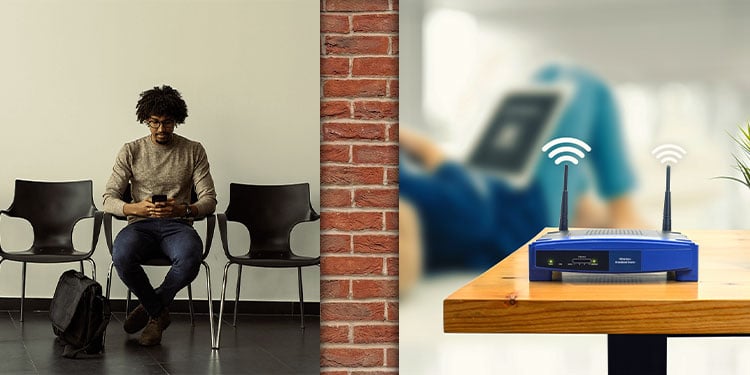Are you tired of
dodgy WiFi signals? Do you feel like your internet connection has been taken hostage by your walls? Well, I have a confession to make.
As a freelance writer, I spend most of my days hunched over my laptop, typing away. One day, I was working on a tight deadline, and my
WiFi connection decided to escapism with me. The signal was weak, and I tried moving my laptop around the room, but nothing seemed to work. In pure frustration, I slammed my laptop shut and threw it across the room, shattering it into a hundred pieces.
Looking back, it was a completely irrational response, but then I discovered some methods that made all the difference.
So what does that mean?
Don't worry; I'm here to help you avoid the same frustrating fate. And now, I'm ready to share those tips on how to boost the WiFi signal through walls with you. Say goodbye to buffering and slow connections and hello to lightning-fast internet. Before we look into the tips, let's take 1 minute to learn about the types of walls and their impact on your WiFi signal.
Types of Walls and their Impact on WiFi Signals
I know what you're thinking: can different walls affect WiFi signals differently?
Of course!
Different types of walls can impact the strength and quality of WiFi signals. It is because different materials have varying radio frequency (RF) signal attenuation, which can weaken the WiFi signal.
For instance, walls made of thick concrete, metal, and brick are more challenging for WiFi signals to penetrate, resulting in weaker signals. On the other hand, walls made of wood, plasterboard, and glass allow WiFi signals to pass through more easily, leading to stronger signals.
So what else can affect the strength of the signal when WiFi goes through walls?
The thickness of a wall also plays a role in signal strength. Thicker walls cause more attenuation than thinner walls. Additionally, the location of the wall to the router also impacts signal strength. Walls perpendicular to the signal path's direction is more challenging for the signal to penetrate than parallel ones.
It's essential to understand the impact of walls on your WiFi signal strength and take steps to improve it. Do you want to know
how to boost the WiFi signal through walls? Next, I will introduce how to use the DIY solution to improve that.
DIY Solutions to Improve WiFi Signal Through Walls
The problem is how I can improve the WiFi signal at home. Here are some easy ways to improve your WiFi signal through walls:
1. Relocate your router: The placement of your router can significantly affect the strength of your WiFi signal. Try moving it to a central location, away from walls and other obstacles blocking the signal.
2. Upgrade your router's firmware: Make sure your router's firmware is up-to-date, as outdated firmware can impact the signal strength.
3. Use powerline adapters: Powerline adapters use your home's electrical wiring to extend your network signal. It can be a useful solution if you have weak WiFi signals in rooms far from your router.
4. Install a WiFi mesh system: A WiFi mesh system is a more advanced solution to create a network of multiple access points. WiFi mesh system provides seamless WiFi coverage throughout your home or office.
These DIY solutions can help boost your WiFi signal through walls. But if none of these methods work, it's time for the WiFi extender to come in.
How to Use WiFi Extenders to Boost WiFi Signals Through Walls?
Stay with me now; are you ready to feel the power of a WiFi extender? WiFi extenders, also known as range extenders, can effectively boost your WiFi signal through walls. Here are the steps to using WiFi extenders:
1. Find a good location for the extender: You should place the extender where it can receive a strong signal from your router. It's usually the center of your house.
2. Connect the extender to your router: Follow the instructions that come with your extender to connect it to your router. It may involve using an Ethernet cable or connecting to your router's WiFi network.
3. Configure the extender: Once your extender is connected to your router, you will need to configure it. This includes accessing the extender's settings page and entering your WiFi network details.
4. Test the connection: Once your extender is set up, test your connection by moving to an area with a weak WiFi signal and checking if the signal strength has improved.
If you install and set up your WiFi extender correctly, you can use the internet faster and more reliably all over your home. On the other hand, there are some actions you can take to minimize interference; let me explain them to you.
How to Minimize Interference with WiFi Signals?
Finally, let's take a look at how to minimize interference with WiFi signals.
One is to ensure your router is in a central location in your home and not near any large metal objects that can block the signal. You can also add a WiFi extender to boost the signal in areas where it is weak.
Another tip is to change the channel your router broadcasts on, as some channels are more prone to interference than others. You can usually find this option in your router's settings.
Last, ensure that devices connected to your WiFi are as close to the router as possible.
By following these tips, you can minimize interference with your WiFi signals and enjoy a more reliable and stable wireless network.
Conclusion
In conclusion, boosting your WiFi signal through walls is possible if you know the right tips and tricks. It's important to try various strategies and determine what works best for your situation. Upgrading your equipment and keeping it up-to-date is also crucial for optimal performance. With patience and effort, you can significantly improve your WiFi signal strength and enjoy uninterrupted internet connectivity.
